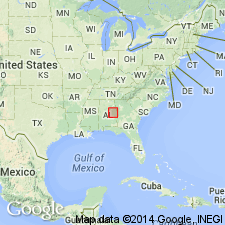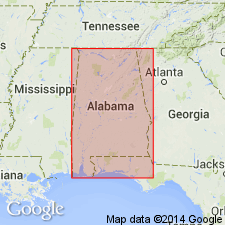
- Usage in publication:
-
- Ketchepedrakee Amphibolite
- Modifications:
-
- Named
- Dominant lithology:
-
- Amphibolite
- AAPG geologic province:
-
- Piedmont-Blue Ridge province
Summary:
Ketchepedrakee Amphibolite here named for exposures along creek in northern Clay Co. Outcrop belt ranges from 100 to 1000 m. Characteristically green to blue-green in color. Hornblende is dominant mineral.
Source: GNU records (USGS DDS-6; Reston GNULEX).

- Usage in publication:
-
- Ketchepedrakee Amphibolite
- Modifications:
-
- Overview
- Revised
- AAPG geologic province:
-
- Piedmont-Blue Ridge province
Summary:
Ketchepedrakee Amphibolite includes all thin amphibolites associated with the Poe Bridge Mountain Group. Unit is dark-green to black fine- to coarse-grained, layered to massive hornblende actinolite-amphibolite with zones or pods of coarse hornblendite and enstatite-hypersthene pyroxenite. May also include a few felsic dikes, widely scattered pegmatites, and screens of schist and gneiss. Magnetite, ilmenite, zoisite, and quartz are common accessory minerals. Generalized age of Precambrian and Paleozoic shown on chart.
Source: GNU records (USGS DDS-6; Reston GNULEX).
For more information, please contact Nancy Stamm, Geologic Names Committee Secretary.
Asterisk (*) indicates published by U.S. Geological Survey authors.
"No current usage" (†) implies that a name has been abandoned or has fallen into disuse. Former usage and, if known, replacement name given in parentheses ( ).
Slash (/) indicates name conflicts with nomenclatural guidelines (CSN, 1933; ACSN, 1961, 1970; NACSN, 1983, 2005, 2021). May be explained within brackets ([ ]).

